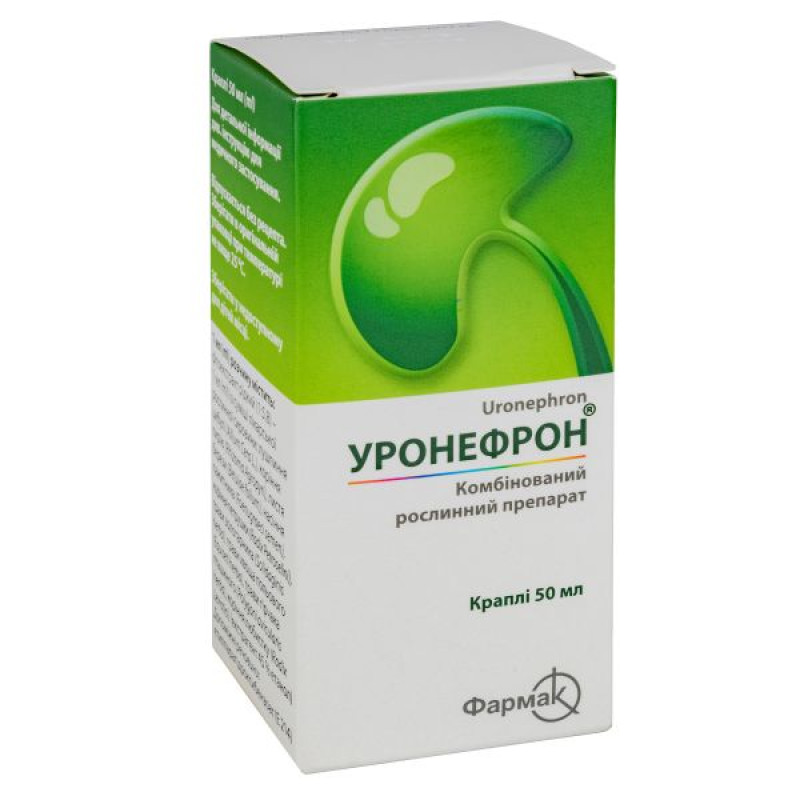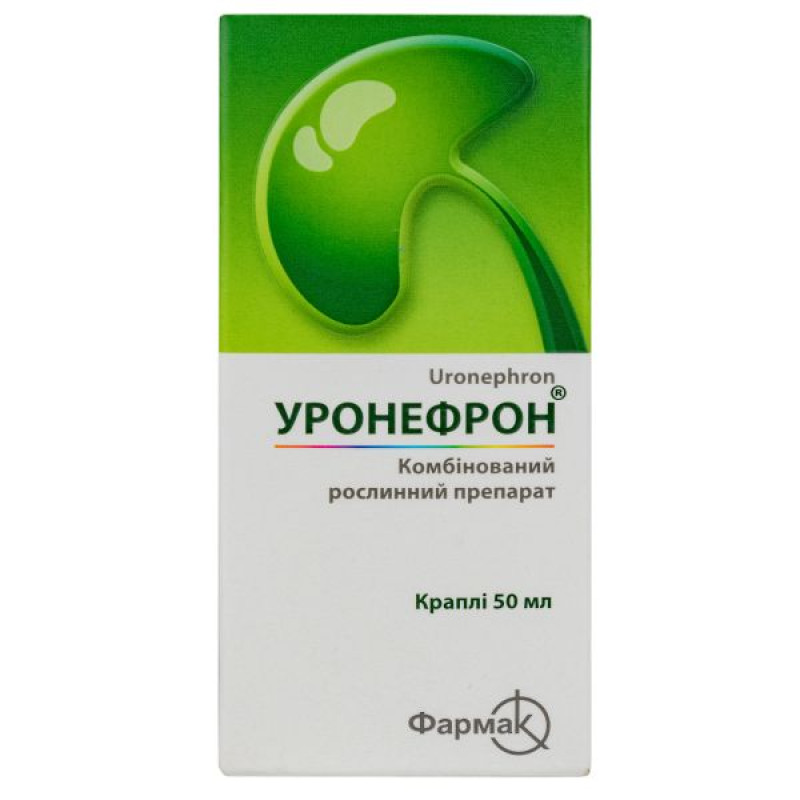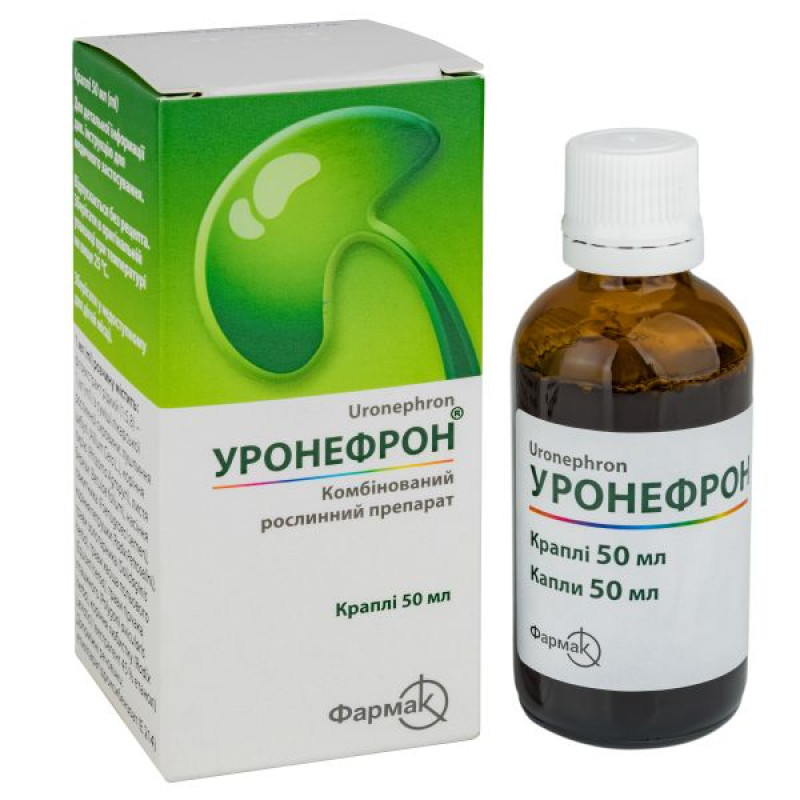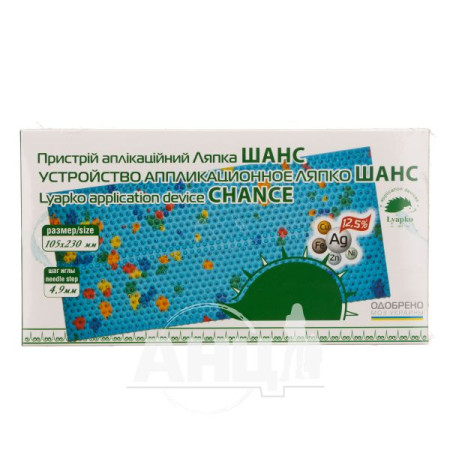Uronefron drops bottle 50 ml

Instructions for Uronefron drops, bottle 50 ml
Composition
active ingredients: 1 ml of solution contains liquid phytoextract (1:5.8) – 1 ml, from a mixture of medicinal plant raw materials: onion husks (Allium Cera L.), wheatgrass roots (Rhizoma Agropyri), birch leaves (Betulae folium), fenugreek seeds (Foenиgraeci semen), parsley roots (Radix Petroselini), goldenrod herb (Solidaginis herba), horsetail herb (Equiseti herba), bird's-foot-thigh herb (Polygoni avicularis herba), lovage roots (Radix Levistici) (extractant 45% ethanol);
excipients: ethyl parahydroxybenzoate (E 214).
There are 27 drops in 1 ml of the drug.
Dosage form
Drops.
Main physicochemical properties: dark brown liquid with a yellowish or greenish tint with a specific aromatic odor. Slight turbidity and small precipitate are allowed.
Pharmacotherapeutic group
Means that help dissolve urinary stones.
ATX code G04B C.
Pharmacological properties
Pharmacodynamics.
Uronefron® is a combined preparation of plant origin. It has anti-inflammatory, diuretic, antispasmodic and antimicrobial effects. The diuretic effect is due to flavone derivatives, inositol, saponins and silicates. The latter also enhance the excretion of uric acid in case of urate deposits in the kidneys. The preparation prevents the crystallization of mineral components in the urinary tract, has a beneficial effect on maintaining the balance between colloids and crystalloids of urine. Saponins reduce surface tension, form protective colloids and emulsify pathogenic components of urine, prevent the formation of sand and stones in the kidneys. Promotes the washing out of sand and small stones, prevents the increase in stones or the appearance of new ones.
Onion husk contains essential oil (up to 0.15%), vitamin C, riboflavin, thiamine, carotenoids, phytic, citric and malic acids, sugars (glucose, fructose, sucrose), flavonoids, potassium, iron, manganese, zinc and cobalt compounds. It has an anti-inflammatory effect.
Creeping wheatgrass. The rhizome contains polysaccharides, sugars, alcohols, glycosides, vitamins, essential and fatty oils, organic acids. The main action is diuretic, regulating metabolism.
Birch leaves contain essential oils, saponins, tannins, resins, ascorbic and nicotinic acids. The main action is diuretic, choleretic, antispasmodic, and anti-inflammatory.
Fenugreek seeds contain trigonelline, nicotinic acid, rutin, steroidal saponins and phytosterols, flavonoids, essential oils. The main action is anti-inflammatory, tonic, and wound healing.
Parsley root contains aponyl, myristicin, and flavonoids. The main action is diuretic, anti-inflammatory, and litholytic.
Goldenrod herb contains flavonoids: kaempferol, quercetin and their glycosides – astragalin, rutin. The main action is diuretic, antibacterial, anti-inflammatory.
Horsetail contains flavonoids: derivatives of apigenin, luteolin, kaempferol, quercetin, also contains phenolcarboxylic acids, tannins, saponins. The main action is diuretic, anti-inflammatory, litholytic, detoxification.
Bird's-foot trefoil herb contains flavonoids, phenolic acids, carotene, ascorbic acid, and tannins. The main action is diuretic and hemostatic.
Lovage. The aerial part and roots of lovage contain essential oil (in fresh roots – 0.1-0.2%, in dry – 0.6-1%), sugars, organic acids, minerals, resins, starch. The composition of the essential oil includes terpineol, cineole, acetic, isovaleric and benzoic acids. The main action is diuretic, anti-inflammatory.
Pharmacokinetics.
Not studied.
Indication
In the complex therapy of infectious and inflammatory diseases of the urinary system:
- acute and chronic cystitis;
- acute and chronic pyelonephritis;
- chronic urethritis;
- chronic prostatitis.
Treatment and prevention of urolithiasis, including after surgical removal of urinary stones.
Contraindication
Hypersensitivity to any component of the drug or to plants of the genus Asteraceae (Compositae) (golden marigold), Apiaceae (Umbelliferae), or anethole (lovage root), birch pollen (birch leaves). Acute glomerulonephritis, acute interstitial nephritis, nephrosis, phosphate lithiasis. Conditions in which reduced fluid intake is recommended (e.g. renal failure, heart failure). Urinary tract obstruction. Conditions accompanied by increased blood clotting.
Interaction with other medicinal products and other types of interactions
Due to the diuretic effect, accelerated elimination of other drugs used in complex therapy is possible. May enhance the effect of hypoglycemic drugs, nonsteroidal anti-inflammatory drugs, MAO inhibitors, anticoagulants. Prolongs the effect of pentabarbital, paracetamol, aminopyrine.
Reduces the absorption of beta-carotene, alpha-tocopherol, and cholesterol in the small intestine.
Application features
When using the drug, glycemic control is necessary in patients with diabetes due to the possible hypoglycemic effect of fenugreek.
If you experience pain, difficulty urinating, blood in the urine, worsening symptoms, or an increase in body temperature, you should immediately consult a doctor.
The drug should not be used in case of edema caused by heart or kidney failure.
The drug contains ethyl parahydroxybenzoate (E 214), which may cause allergic reactions (possibly delayed).
The drug contains a small amount of ethanol - less than 100 mg/dose.
Use during pregnancy or breastfeeding
It is not recommended to take the drug during pregnancy or breastfeeding.
Ability to influence reaction speed when driving vehicles or other mechanisms
If dizziness occurs during treatment with the drug, you should refrain from driving vehicles and operating machinery.
Method of administration and doses
Apply internally to adults.
Take 25-30 drops 3-4 times a day after meals, dissolved in 100 ml (1/2 cup) of warm boiled water.
The duration of the treatment course is determined by the doctor. Usually the course of treatment is from 2 to 6 weeks. If necessary, the course of treatment can be repeated.
Children
There is no experience with the use of the drug in children, so it should not be prescribed to patients in this age category.
Overdose
In case of overdose, the manifestations of adverse reactions may be increased.
Treatment is symptomatic.
Adverse reactions
Allergic reactions, including rashes, urticaria, itching, allergic rhinitis; photosensitivity is possible with increased sensitivity to ultraviolet rays; in some cases - gastrointestinal disorders, nausea, taste disturbances, vomiting, diarrhea, bloating, renal colic, dizziness.
Expiration date
2 years.
Do not use the drug after the expiration date indicated on the package.
Storage conditions
Store in the original packaging at a temperature not exceeding 25 °C.
Keep out of reach of children.
Packaging
25 ml or 50 ml in a bottle. 1 bottle in a pack.
Vacation category
Without a prescription.
Producer
PJSC "Farmak".
Location of the manufacturer and its business address
Ukraine, 04080, Kyiv, Frunze St., 74.
There are no reviews for this product.
There are no reviews for this product, be the first to leave your review.
No questions about this product, be the first and ask your question.















